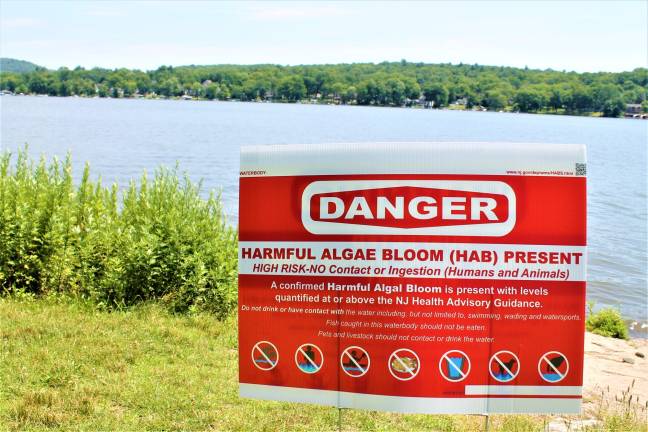State advises no Greenwood Lake water contact due to dangerous algal bloom

A potentially harmful algal bloom caused the state to effectively restrict activities on Greenwood Lake Tuesday after preliminary testing showed the presence of higher than accepted levels of bacteria that could signal a dangerous bloom, officials said.
According to the advisory, people and pets should not come in contact with the water in the lake while the bloom is present, possibly causing rashes, allergy-like symptoms, respiratory irritation, gastroenteritis and eye irritations, according to the state Department of Environmental Protection.
“We are in the early stages of working with the state to understand the overall risk and exposure,” Dale said Tuesday. “We put an advisory on the (town’s) website and we are putting it out through the media channels to get the word out to residents of the township.”
Signs were put up at state-owned Brown’s Point Park and the Greenwood Lake Dam to notify residents of the issue and cutting off public swimming.
The blooms take place in lakes when there is a heavier than normal amount of phosphorus in the water, which serves as a nutrient for the algae, which then grows with warm temperatures, officials from the DEP said.
Dr. Fred Lubnow, director of aquatic programs for Princeton Hydro, said that the firm is currently testing the waters of Greenwood Lake in both New York and New Jersey.
The more of these nutrients that run off into the water, the more favorable the conditions for the harmful algae to grow, Lubnow said.
The blooms are visible and can appear on the water’s surface looking like a green paint spill or a “pea soup” consistency, according to the DEP.
The advisory led to the closing of public swimming areas on Greenwood Lake Tuesday, according to the DEP.
A similar bloom caused the closing of swimming areas and an advisory to not come in contact with the water at Lake Hopatcong late last month, officials said.
Lake Hopatcong is the largest body of freshwater in the state.
DEP officials said that closing down that lake could last for weeks as the bloom clears, but a timeline for Greenwood Lake is not yet estimated.
Greenwood Lake Commission Co-Chairman Paul Zarrillo said the public should observe the advisory and that the state will continue testing on the lake until a final determination on the bloom is made by the state.
“Obviously the commission is very concerned,” Zarrillo said Tuesday. “It’s a major health issue to boaters, users of the lake. Until we get final notification from the DEP, we are making preparations for the worst news.”
Zarrillo said the commission would have to make signs and notify the various beach associations, marinas, and other lake activity outlets should the bloom be confirmed.
He said that while the state can restrict water activities, or even ticket violators on its property, it cannot enforce the advisory on private property.
“If this becomes a case, we would make it known to everyone not to swim, or you are swimming at your own risk,” he said. “(The commission) can give warnings.”
The state maintains a website where people can check for water quality problems with lakes near them at https://www.nj.gov/dep/wms/bfbm/cyanoHABevents.html.
The Greenwood Lake advisory, however, was not yet listed as of Tuesday afternoon.
Zarrillo said that the testing is ongoing and that it may take sometime to get the final results and have the lake listed on the website.
Greenwood Lake, New York, Mayor Jesse Dwyer said that state's side of the lake is not impacted by the findings and remains open as usual.
In a telephone interview, Dwyer said the New York side of the lake is deeper and that testing for toxins on that end is drastically lower than the results in New Jersey.
"The New Jersey end is about 4-6 foot (deep), while it's about 20-feet (in New York)," he said.
He also said testing on the New York end would continue.